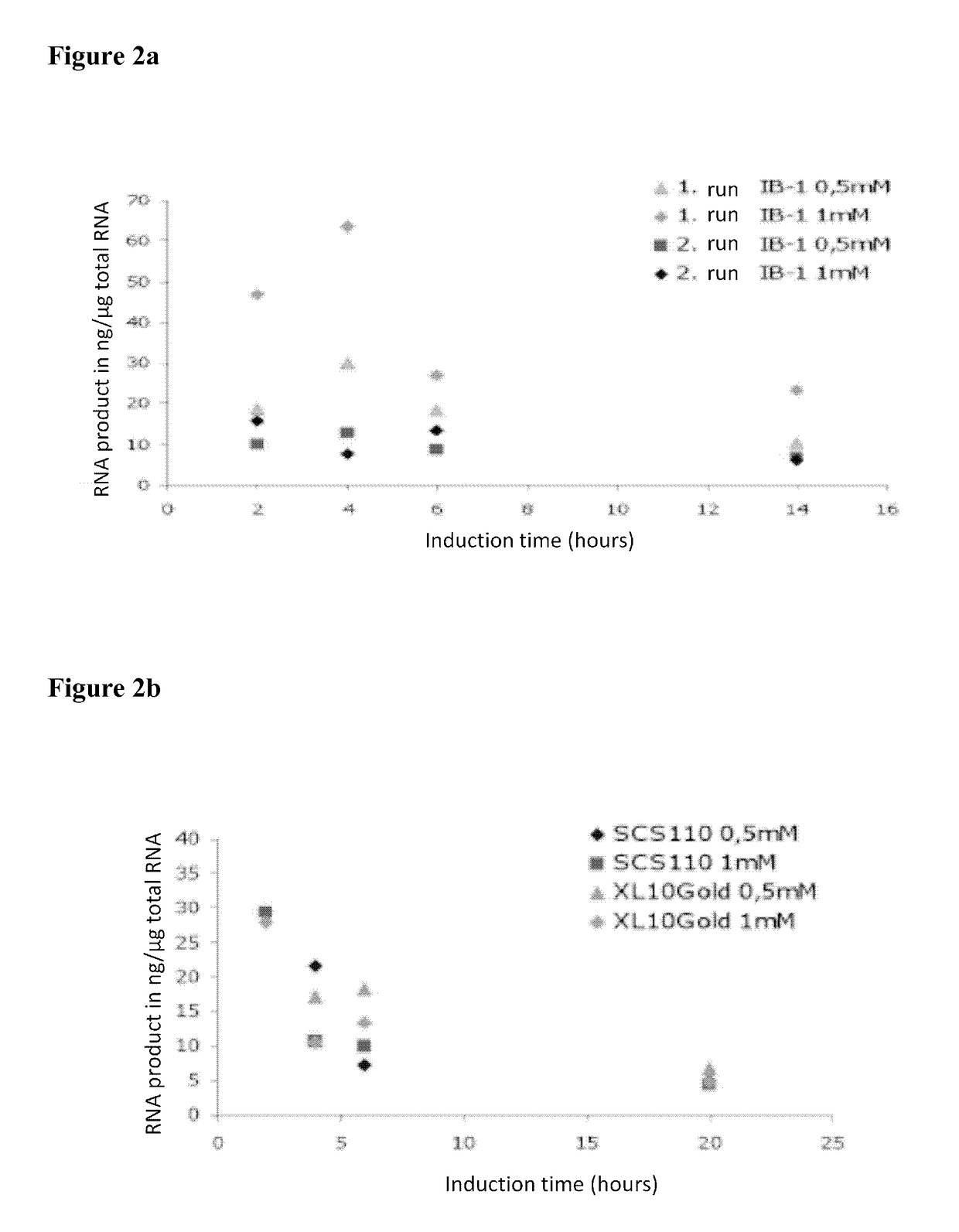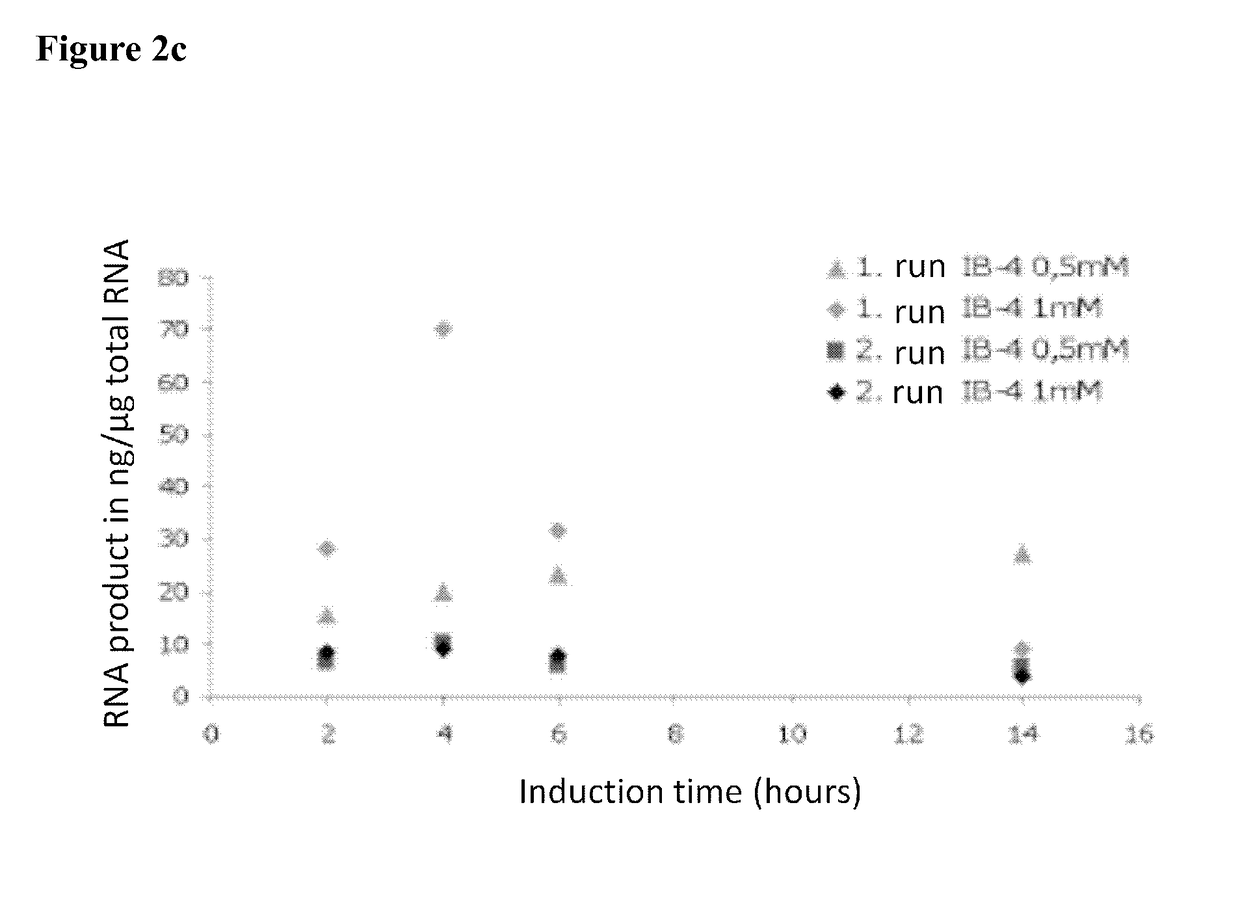Process for the in vivo production of RNA in a host cell
a technology host cell, which is applied in the field of in vivo production of rna in a host cell, can solve the problems of loss of function of genes, undesired generation of anti-dna antibodies, and limited expression level of encoded peptides or proteins that can be achieved
- Summary
- Abstract
- Description
- Claims
- Application Information
AI Technical Summary
Benefits of technology
Problems solved by technology
Method used
Image
Examples
example 1
f Vectors
[0227]The cloning of five different vector constructs IB-1, IB-3, IB-4, IB-5, IB-6 encoding the target RNA was carried out as follows:
[0228]For the target RNA to be transcribed in vivo, a non-coding DNA sequence of 500 base pairs (SEQ ID No. 1) corresponding to the target RNA was inserted into each vector construct. In vector constructs IB-5 and IB-6 the start codon was deleted and three additional stop codons were inserted to prevent any translation into recombinant protein.
[0229]The DNA sequence encoding the target RNA further included six restriction sites (3 on each end of the sequence (at the 5′-end: BGIII, NdeI, BamHI; at the 3′-end: XhoI, AvrII, BlpI).
[0230]In vector constructs IB-5 and IB-6, the DNA sequence encoding an RNase inhibitor was additionally inserted. Vector construct IB-5 comprised the DNA sequence of the RraA gene of E. coli strain K12 (Accession No POA8R0; UniProtKB; SEQ ID No. 3), vector construct IB-6 comprised the DNA sequence of the human RNase inh...
example 2
ranscription of Target RNA
[0236]In vivo transcription experiments were carried out with the transformed E. coli strains listed in Table 1 as follows.
[0237]The E. coli cultures in 20 ml LBamp-medium were incubated overnight at 37° C. and at 142 rpm. From these overnight cultures, 10 ml were used to prepare 50 ml production cultures by adding 40 ml fresh LBamp medium and growing the cultures to OD600 of 0.6. The cultures were induced by adding 0.5 mM and 1 mM IPTG, respectively, while the temperature was lowered to room temperature. Cultivation was continued for 2 h, 4 h, 5 h, and 20 h.
[0238]The RNA from the cultures was subsequently isolated using the RNeasy kit (Qiagen) according to the manufacturer's purification protocol.
[0239]Detection of the formed target RNA after in vivo transcription in E. coli was carried out by RT-PCR. The target RNA was converted in a first step into the complementary cDNA. In a second step the cDNA was further amplified.
[0240]The primers used in the RT-PC...
example 3
of the Target RNA by Northern Blot and Dot Blot
[0257]For a sequence-specific detection of the in vivo transcribed target RNA, northern blotting was carried out using a DNA probe of vector construct IB-1. The probe was labeled with dioxigenin using the PCR DIG Probe Synthesis Kit (Roche). As a positive control, in vitro transcribed vector construct IB-1 was used. As negative control total RNA of E. coli was used. FIG. 6 shows the result of the Northern Blot with the following lanes.
1—size marker
2—positive control 0.1 ng
3—positive control 1 ng
4—positive control 5 ng
5—positive control 50 ng
6—positive control 100 ng
7—positive control 250 ng
8—no sample
9—positive control 500 ng
10—no sample
11—positive control 1000 ng
12—no sample
13—RNA sample generated from vector construct IB-5 (0.5 mM IPTG, 5 h)
14—RNA sample generated from vector construct IB-5 (1 mM IPTG, 5 h)
15—RNA sample generated from vector construct IB-6 (0.5 mM IPTG, 4 h)
16—RNA sample generated from vector construct IB-6 (1 mM IPTG...
PUM
| Property | Measurement | Unit |
|---|---|---|
| temperature | aaaaa | aaaaa |
| temperature | aaaaa | aaaaa |
| temperature | aaaaa | aaaaa |
Abstract
Description
Claims
Application Information
 Login to View More
Login to View More - R&D
- Intellectual Property
- Life Sciences
- Materials
- Tech Scout
- Unparalleled Data Quality
- Higher Quality Content
- 60% Fewer Hallucinations
Browse by: Latest US Patents, China's latest patents, Technical Efficacy Thesaurus, Application Domain, Technology Topic, Popular Technical Reports.
© 2025 PatSnap. All rights reserved.Legal|Privacy policy|Modern Slavery Act Transparency Statement|Sitemap|About US| Contact US: help@patsnap.com



